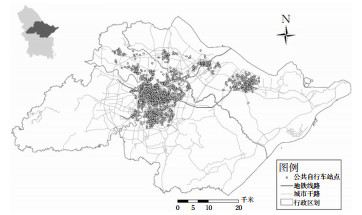Travel Characteristics and Influencing Factors of Bike Sharing Based on Spatial Lag Model
-
摘要: 为充分挖掘公共自行车时空出行特征,探讨城市空间环境与骑行需求的潜在联系。以宁波市中心城区为案例,基于公共自行车IC卡数据获取出行时空变化规律,在验证租、还车需求具有空间自相关性的基础上,通过建立空间滞后模型,分析了人口密度、道路分布、公共交通、站点配置和建成环境因素对骑行需求的影响。研究表明:①工作日、非工作日内租、还车需求的全局Moran's I分别为0.294,0.281,0.272和0.271,表现出显著的空间正相关性;②各模型的拟合优度R2分别是0.431,0.424,0.412,0.401,具有良好的拟合效果与解释性;③道路分布、建成环境变量对公共自行车使用的影响效应存在时间差异,其中公交专用道里程与非工作日内的站点需求量呈负相关,工作日内POI混合度对租、还车需求具有正向引导作用。Abstract: The paper aims to investigate the spatial-temporal characteristics of the bike sharing system(BSS)and quantify factors affecting BSS usage from the urban spatial environment. The spatio-temporal analysis is conducted to investigate the mobility pattern of BSS using the massive IC-card data in central urban area of Ningbo, China. By considering the spatial autocorrelation of pick-up and drop-off, a spatial lag model is established to identify the internal relationship between BSS usage and spatial variables from population density, road distribution, public transportation, station infrastructure, and built environment. The results show that: ①The global Moran's I for pick-up and drop-off on weekdays and weekends is 0.294, 0.281, 0.272, and 0.271, indicating the spatial correlation is significantly positive. ②The goodness of fit is 0.431, 0.424, 0.412, and 0.401, showing that these models have good fitness and explanatory. ③There are also significant temporal differences between road distribution and built environment variables influencing BSS usage. The length of bus lanes is negatively correlated with the usage demand during weekends, and the POI mixing degree positively affects the demand for pick-up and drop-off on weekdays.
-
Key words:
- traffic engineering /
- bike sharing /
- influencing factors /
- spatial lag model /
- built environment
-
表 1 解释变量描述统计
Table 1. Descriptive statistics of explanatory variables
解释变量 平均值 标准差 VIF 标注 人口密度 人口密度/(千人/km2) 0.53 0.23 1.49 D_pop 主干路里程/km 0.22 0.25 1.79 L_major 道路分布 次干路里程/km 0.28 0.26 1.46 L_sub 支路里程/km 0.30 0.28 1.23 L_branch 公交专用道里程/km 0.10 0.19 1.70 L_prior 公共交通 地面公交站点数量/km 1.33 0.69 1.80 N_me tr o 地铁站点数量 0.03 0.15 1.23 N_bus 站点配置 站点粧位数量 28.96 9.28 1.02 C_station 缓冲区内粧位总量 33.34 36.73 1.21 C_buffer 建筑设施 居住社区型POI数量 12.11 15.63 1.57 POI_res 公共服务型POI数量 12.81 13.16 3.24 POI_pub 商业服务型POI数量 86.93 109.63 3.53 POI_com 工业用地型POI数量 15.18 18.48 1.99 POI_ind 交通设施型POI数量 10.86 10.27 4.53 POI_trans 广场绿地型POI数量 0.93 2.63 1.21 POI_park POI分布总量 43.07 13.08 4.25 POI_total POI混合度 2.50 0.76 1.57 POI_gini 表 2 模型检验结果
Table 2. Results of the model test
模型 指标 LM-lag LM-Error Robust LM-lag Robust LM-Error 模型Ⅰ (Y=WDP) Value 88.191 52.480 46.122 10.414 P值 0.000 0.000 0.000 0.001 模型Ⅱ(Y=WDD) Value 105.800 68.735 45.813 8.792 P值 0.000 0.000 0.000 0.033 模型Ⅲ(Y=WEP) Value 84.290 48.642 48.560 12.911 P值 0.000 0.000 0.000 0.000 模型Ⅳ(Y=WED) Value 97.902 62.513 45.569 10.180 P值 0.000 0.000 0.000 0.001 表 3 拟合结果
Table 3. Fitting results of the model
变量 模型Ⅰ 模型Ⅱ 模型Ⅲ 模型Ⅳ W_ln(Y) 0.22r 0.267** 0.258** 0.251** Constant 1.469** 1.401** 1.475** 1.573** D_pop 0.877** 0.869** 0.841** 0.852** L_major 0.359* 0.342* 0.369* 0.341* L_sub 0.312* 0.351** 0.218 0.213 L_branch —0.166 —0.175 —0.273** —0.272* L_prior —0.340 —0.293 C_station 0.009** 0.007* 0.006 0.005 POI_res 0.007 0.006 POI_pub 0.006 0.006* 0.004* 0.008* POI_ind —0.004 —0.003 POI_total 0.087* 0.087* 0.083 0.081 POI_gini 0.079 0.073 R2 0.431 0.424 0.412 0.401 AIC 2 801.52 2 798.69 2 899.43 2 881.59 Log —1 381.76 —1 380.34 —1 430.72 —1 421.79 注:*代表 p <0.01;**代表 p <0.001。 -
[1] SOHRABI S, PALETI R, BALAN L, et al. Real-time prediction of public bike sharing system demand using generalized extreme value count model[J]. Transportation Research Part A: Policy and Practice, 2020(133): 325-336. http://ideas.repec.org/a/eee/transa/v133y2020icp325-336.html [2] EL-ASSI W, MAHMOUD M, HABIB, K. Effects of built environment and weather on bike sharing demand: A station level analysis of commercial bike sharing in Toronto[J]. Transportation, 2017, 44(3): 589-613. doi: 10.1007/s11116-015-9669-z [3] LIN Pengfei, WENG Jiancheng, LIANG Quan, et al. Impact of weather conditions and built environment on public bikesharing trips in Beijing[J]. Networks and Spatial Economics, 2020, 20(1): 1-17. doi: 10.1007/s11067-019-09465-6 [4] SUN Y, MOBASHERI A, HU X, et al. Investigating impacts of environmental factors on the cycling behavior of bicycle-sharing users[J]. Sustainability, 2017, 9(6): 1060-1072. doi: 10.3390/su9061060 [5] 尹秋怡, 甄峰, 罗桑扎西, 等. 新城公共自行车出行空间影响因素及布局建议[J]. 现代城市研究, 2018(12): 9-15+46. doi: 10.3969/j.issn.1009-6000.2018.12.002YIN Qiuyi, ZHEN Feng, LUO Sangzhaxi, et al. Influencing factors and layout suggestions of public bicycle travel space in the new city[J]. Modern Urban Research, 2018(12): 9-15+46. (in Chinese) doi: 10.3969/j.issn.1009-6000.2018.12.002 [6] LIN J, ZHAO P, TAKADA K, et al. Built environment and public bike usage for metro access: a comparison of neighborhoods in Beijing, Taipei, and Tokyo[J]. Transportation Research Part D: Transport and Environment, 2018(63): 209-221. http://www.sciencedirect.com/science/article/pii/S1361920917307198 [7] BAO Jie, SHI Xiaomeng, ZHANG Hao. Spatial analysis of bikeshare ridership with smart card and POI data using geographically weighted regression method[J]. IEEE Access, 2018(6): 76049-76059. [8] FAGHIH-IMANI A, ELURU N. Incorporating the impact of spatio-temporal interactions on bicycle sharing system demand: A case study of New York Citibike system[J]. Journal of Transport Geography, 2016(54): 218-227. [9] MA Xinwei, JI Yanjie, JIN Yuchuan, et al. Modeling the factors influencing the activity spaces of bikeshare around metro stations: A spatial regression model[J]. Sustainability, 2018, 10 (11): 3949. doi: 10.3390/su10113949 [10] 杜明洋, 程琳, 李雪峰. 基于自适应粒子群小波网络的公共自行车出行需求预测[J]. 公路交通科技, 2019, 36(6): 94-102. https://www.cnki.com.cn/Article/CJFDTOTAL-GLJK201906013.htmDU Mingyang, CHENG Lin, LI Xuefeng. Prediction of public bike trip demand based on APSO-WNN[J]. Journal of Highway and Transportation Research and Development, 2019, 36 (6): 94-102. (in Chinese) https://www.cnki.com.cn/Article/CJFDTOTAL-GLJK201906013.htm [11] LIU H, LIN J. Associations of built environments with spatiotemporal patterns of public bicycle use[J]. Journal of Transport Geography, 2019, 74(3): 299-312. http://www.sciencedirect.com/science/article/pii/S0966692318305660 [12] ORNL."2017 LandScan data for population distribution from the Oak Ridge National Laboratory in USA."[R/OL]. (2018-06)[2020-12-09]. https://landscan.ornl.gov/. [13] 池娇, 焦利民, 董婷, 等. 基于POI数据的城市功能区定量识别及其可视化[J]. 测绘地理信息, 2016, 41(2): 68-73. https://www.cnki.com.cn/Article/CJFDTOTAL-CHXG201602018.htmCHI Jiao, JIAO Limin, DONG Ting, et al. Quantitative identification and visualization of urban functional area based on POI data[J]. Journal of Geomatics, 2016, 41(2): 68-73. (in Chinese) https://www.cnki.com.cn/Article/CJFDTOTAL-CHXG201602018.htm [14] 庄楚天, 吴戈. 基于站点爬虫数据的公共自行车系统时空特征分析[J]. 交通信息与安全, 2017, 35(3): 51-58. doi: 10.3963/j.issn.1674-4861.2017.03.007ZHUANG Chutian, WU Ge. Spatial-temporal characteristics of a shared bicycle system based on web crawler data[J]. Journal of Transport Information and Safety, 2017, 35(3): 51-58. (in Chinese) doi: 10.3963/j.issn.1674-4861.2017.03.007 [15] ANSELIN L. Spatial econometrics: Methods and models[M]. Dordrecht: Kluwer Academic Publishers, 1988. [16] NKURUNZIZA A, ZUIDGEEST M, BRUSSEL M. Examining the potential for modal change: Motivators and barriers for bicycle commuting in Dares-Salaam[J]. Transport Policy, 2012 (24): 249-259. [17] ZHANG Ying, THOMAS T, BRUSSEL M, et al. Exploring the impact of built environment factors on the use of public bikes at bike stations: Case study in Zhongshan, China[J]. Journal of Transport Geography, 2017(58): 59-70. http://www.sciencedirect.com/science/article/pii/S0966692316300412 [18] GUO Yanyong, ZHOU Jibiao, WU Yao, et al. Identifying the factors affecting bike-sharing usage and degree of satisfaction in Ningbo, China[J]. Plos One, 2017, 12(9): 1-19. http://www.ncbi.nlm.nih.gov/pubmed/28934321 [19] 张敏捷, 周继彪, 董升, 等. 城市公共自行车准动态调度方法[J]. 交通运输系统工程与信息, 2019, 19(5): 185-192. https://www.cnki.com.cn/Article/CJFDTOTAL-YSXT201905026.htmZHANG Minjie, ZHOU Jibiao, DONG Sheng, et al. Quasi-dynamic balancing method for urban public bike-sharing system[J]. Journal of Transportation Systems Engineering and Information Technology, 2019, 19(5): 185-192. (in Chinese) https://www.cnki.com.cn/Article/CJFDTOTAL-YSXT201905026.htm [20] 于乐, 谢秉磊, 张鹍鹏, 等. 职住地建成环境对网约车通勤出行影响研究[J]. 交通信息与安全, 2019, 37(6): 149-155. https://www.cnki.com.cn/Article/CJFDTOTAL-JTJS201906019.htmYU Le, XIE Binglei, ZHANG Kunpeng, et al. Impacts of built environments on car-hailing commuting in job-housing locations[J]. Journal of Transport Information and Safety, 2019, 37 (6): 149-155. (in Chinese) https://www.cnki.com.cn/Article/CJFDTOTAL-JTJS201906019.htm -





 下载:
下载:





